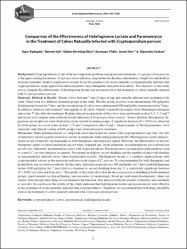Comparison of the effectiveness of halofuginone lactate and paromomycin in the treatment of calves naturally ınfected with cryptosporidium parvum

Göster/
Erişim
info:eu-repo/semantics/openAccessTarih
2018Yazar
Aydoğdu, UğurIşık, Nermin
Ekici, Özlem Derinbay
Yıldız, Ramazan
Şen, İsmail
Coşkun, Alparslan
Üst veri
Tüm öğe kaydını gösterÖzet
Background: Cryptosporidiosis is one of the most important problems among neonatal ruminants. Cryptosporidium parvum is the agent causing the disease. Cryptosporidium infection, responsible for diarrhea, dehydration, weight loss and death in neonatal ruminants, leads to significant economic losses for producers. In calves naturally or experimentally infected with cryptosporidiosis, many agents have been reported to have therapeutic and protective effects. The objective of this study was to compare the effectiveness of halofuginone lactate and paromomycin in the treatment of calves naturally infected with Cryptosporidium parvum.
Materials, Methods & Results: Twenty calves between 7 and 20 days of age and naturally infected were included in the study. There were two different treatment groups in the study. The first group of calves were administered 100 mu g/kg/day halofuginone lactate for 7 days and the second group of calves were administered 100 mg/kg/day paromomycin for 7 days. In addition, antibiotic and vitamin C were applied to all calves. Jugular venous blood samples were obtained pre-treatment and on the 7th day after the treatment. Routine clinical examinations of the calves were performed on days 0, 1, 3, 5 and 7 and rectal stool samples were collected for the detection of Cryptosporidium oocysts. Severe diarrhea, dehydration, depression and weight loss were observed in calves in both treatment groups. A significant decrease (P < 0.05) was observed for both groups in oocyst count on days 3, 5 and 7 compared to days 0 and 1. Improvements in blood parameters, stool characters and clinical scoring of both groups were observed in post-treatment.
Discussion: Many pharmaceuticals or compounds have been tested for animal with cryptosporidiosis and only very few of them have shown a partial protective activity in ruminants when used prophylactically. Halofuginone lactate and paromomycin are commonly recommended as both therapeutic and protective agents. However, the effectiveness of the two therapeutic agents in natural infections has not been compared and, in the meantime, recommendations for a rational use are also not sufficiently documented in calves with cryptosporidiosis. Paromomycin is an aminoglycoside antibiotic used to control C. parvum infection in animals. Paromomycin reduces oocyst shedding and the number of days with diarrhea in experimentally infected calves when used prophylactically. Halofuginone lactate is a synthetic quinazolinone with cryptosporidial activity in the merozoite and sporozoite stages of C. parvum. It is recommended for both therapeutic and prophylactic use in cryptosporidiosis. In this study, although paromomycin (100 mg/kg/day for 7 days) and halofuginone lactate (100 mu g/kg/day for 7 days) led to a decrease in oocyst shedding from day 1, a statistically significant decrease (P < 0.05) was observed from day 3. The results of this study show that the decrease in oocyst shedding in both treatment groups, improvements in clinical findings and recoveries in hematologic, blood gas and serum biochemistry values are similar. Even though these drugs do not eliminate the infection, they decrease both the severity of diarrhea and contribute to recovery. In conclusion, the results of this study indicated that halofuginone lactate and paromomycin were effective in the treatment of calves naturally infected with cryptosporidiosis. Therefore, we recommend that both drugs should be used in the treatment of calves naturally infected with Cryptosporidium parvum.

















